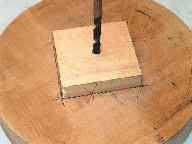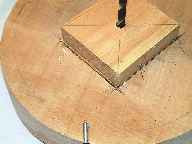narrowboater
Established Member
I have been tasked with making a cheese board. I have a chunk of wood (not sure what it is) and the plan is to end up with a 12" circular board. The top needs to be flat, unlike a platter, and I don't want to loose too much thickness. The blank is about 2" thick.
My plan is to proceed as if it were a bowl or platter, Mount it by the top, Turn the bottom, with a recess to fit my chuck, Reverse it and turn the top, then reverse again in my large cole chuck and turn off the recess.
I saw a video the other day of someone turning a bowl using a glue chuck, ie attaching the blank to a scrap of wood using hot melt glue, Question is what would you think about using this method on a blank 12"x2"?
The alternative is either a screw chuck of faceplate, what sort of depth of screw do you think would be acceptable?
Regards
Rod
My plan is to proceed as if it were a bowl or platter, Mount it by the top, Turn the bottom, with a recess to fit my chuck, Reverse it and turn the top, then reverse again in my large cole chuck and turn off the recess.
I saw a video the other day of someone turning a bowl using a glue chuck, ie attaching the blank to a scrap of wood using hot melt glue, Question is what would you think about using this method on a blank 12"x2"?
The alternative is either a screw chuck of faceplate, what sort of depth of screw do you think would be acceptable?
Regards
Rod









































